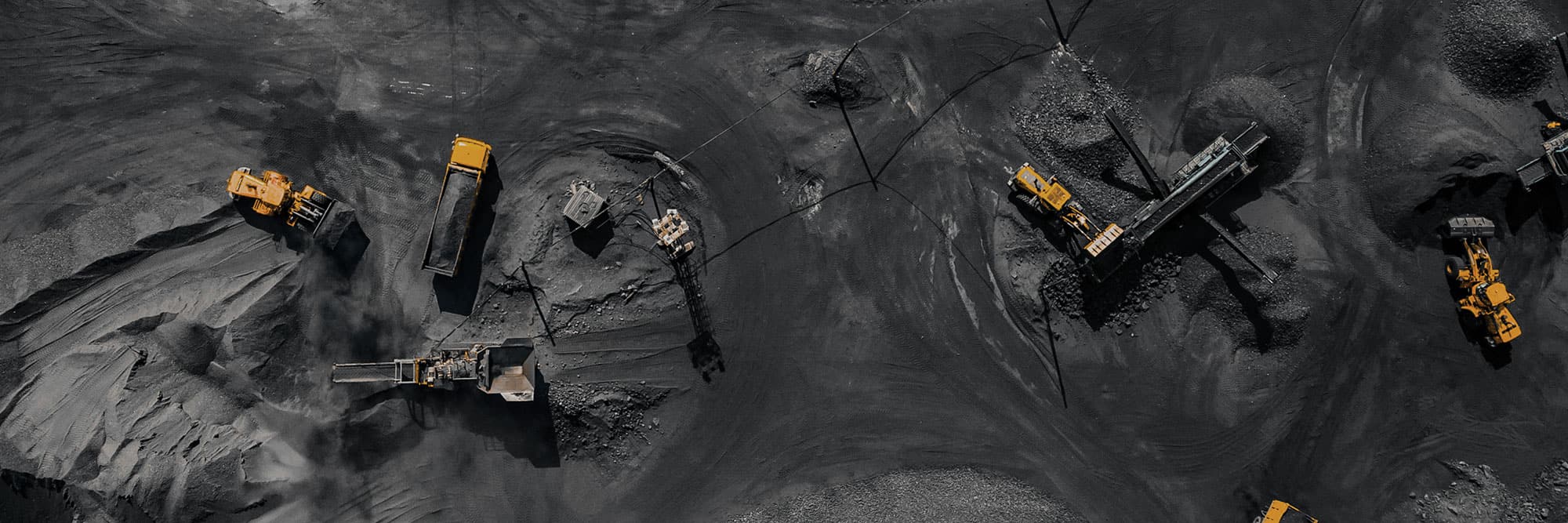Return of Coal Trading and its Risks
Coal is one of the oldest and most prominent sources of energy on the earth’s surface. Coal trading can be traced back as early as the Roman and Aztec Empire. With the industrial revolution and invention of the steam engine, coal became widely used for electricity due to its excellent combustible properties.
Fast-forward to today, coal is an important part of our lives powering 36.49% of the electricity in the world. It is the second most used energy resource after oil. Despite its huge importance, coal has come under a lot of criticism in recent years due to its impact on the environment. With the increasing adoption of renewable sources of energy, many environmental experts expect coal to be completely phased out in the future. Numerous countries have pledged to achieve a carbon-zero status. However, that is not entirely practical. Coal has been and will remain an important part of our lives in the future. The only things which will change are its mining methods and usage, which are expected to improve with the advent of technology. As their market experiences evolve, we see both miners and industrial consumers increasingly engaging in financial risk management.
Before moving to the future of coal, let us go back and learn about the science behind coal.
What is Coal?
Coal is a black or brownish-black sedimentary rock that is formed over millions of years from dead plants. Before the age of dinosaurs, the Earth was covered by swamps that consisted of huge plants. Upon dying, the plants sank to the bottom of the swamps, where they got covered by dirt and water over time. Over the years, these plants changed into coal due to extreme heat and pressure. As coal is formed over millions of years, it is considered a non-renewable source that is available in limited quantity.
Properties and Applications
Coal is made up of various elements such as ash, carbon, hydrogen, oxygen, and sulphur. It has many attributes such as hardness, grindability, and reflectivity that help miners to differentiate between different qualities of coal. This will also determine the type of equipment to be used. The energy in coal is stored in the form of carbon and hydrocarbons and released through combustion (burning).
Coal is a vital energy source that has multiple applications such as power generation, metal production, cement production, gasification and liquefaction, chemical production, and various other industries. The primary reason behind the use of coal in vital industries is that it can be easily transported, and it is relatively cheap.
History of Coal Mining and Trading

Historians have traced back the origins of coal trading to as early as the era of cavemen who used it for cooking and heating. Coal was later found to be also used by the Romans in England (100-200 AD) and Hopi Indians (1300s) for various purposes. The invention of the steam engine by James Watt and the industrial revolution was a turning point for coal. Coal became the primary energy source for powering the steam engine, later followed by steamships and steam-powered railroads. During the American civil war from 1861 to 1865, coal was used in weapons factories for manufacturing steel. In the 1880s, coal was burnt for the first time to produce electricity.
The first coal mining experiment was carried out in England during the 17th century. However, mining on a wide scale only started after the establishment of ironworks and railways. Global coal trading did not start until the 1960s with countries using coal to initially fulfil their domestic demands. Japan and Europe drastically increased their coal imports, while Australia, Canada and the U.S.A. significantly increased their coal exports.
Global Coal Market in the past decade
The global coal market has undergone significant changes in the past decade, driven by shifting demand patterns and a growing focus on sustainability. While coal has long been an essential fuel for electricity generation and other industries, its role in the global energy mix is increasingly coming under scrutiny due to concerns about its impact on the environment. However, despite those concerns, coal continues to be a significant source of energy for many countries around the world.
The global coal market is characterised by a small number of major producers and exporters, as well as varying levels of consumption across different regions. China is by far the largest coal producer in the world, with production reaching 3.75 billion metric tons in 2020, according to the International Energy Agency (IEA). The country is also the largest consumer of coal, using the fossil fuel for over 57% of its electricity generation. However, China has also made significant investments in renewable energy in recent years, and has set a target of achieving carbon neutrality by 2060.
India is the second-largest coal producer in the world, with production reaching 729 million metric tons in 2020. The country is heavily reliant on coal for electricity generation, using it for over 70% of its power needs. However, India has also set a target of achieving 450 GW of renewable energy capacity by 2030, and has made significant investments in solar and wind power in recent years.
Australia is the largest coal exporter in the world, with coal exports reaching 427 million metric tons in 2020. The country is also a major producer of coal, with production reaching 502 million metric tons in 2020. Most of Australia’s coal exports go to Asia, with Japan, China, and South Korea being the largest importers.
Indonesia is the second-largest coal exporter in the world, with coal exports reaching 391 million metric tons in 2020. The country is also a major producer of coal, with production reaching 610 million metric tons in 2020. Most of Indonesia’s coal exports go to Asia, with China and India being the largest importers.
Despite the growth of renewable energy, coal remains an important source of energy for many countries around the world. According to the IEA, coal accounted for around 36% of global electricity generation in 2020, down from 38% in 2019. However, the use of coal is declining in many developed countries, with some countries, such as the United Kingdom, setting targets to phase out coal-fired power plants entirely in the coming years.
Environmental issues and the Paris Agreement
Coal has been one of the most important elements on the earth’s surface and has played a key role in shaping various countries. Contrastingly, it is also the biggest reason behind climate change and global warming. The burning of coal is responsible for one-fifth of the global greenhouse gas emissions. It is the highest source of GHG emissions.
The primary concern of environmentalists has been to phase out unabated coal. That is the coal that involves its usage without any technology to significantly reduce its CO2 emissions through. In simple terms, the CO2 emissions from unabated coal are higher than from abated coal. In contrast “clean coal” refers to the installation of sophisticated pollution control equipment for a coal plant. Those would absorb 100% of the generated carbon dioxide. Then that CO2 has to be kept out of the atmosphere somehow. The major proposal is to inject it underground for long-term sequestration, or to increase the productivity of oil wells. However, the geology necessary for this to operate is difficult to discover. The known use and disposal capabilities are insufficient to convert most coal plants to clean coal systems. Carbon capture is not seen as a realistic climate change prevention solution unless that issue is overcome.
United Nations Climate Change Conference
The Paris Agreement reached at COP 21 in 2015 was a historical milestone for the entire world. Various countries declared their plans to reduce dependence on coal and focus on reducing CO2 emissions. Several countries even pledged to become carbon-neutral by 2050. The COP 26 held in 2021 has further made people question the future demand for coal, with 23 countries committing to completely phase out coal. This included some of the world’s largest coal-generating countries such as South Korea, Indonesia, Poland, Vietnam, and Ukraine. Apart from this, major banks and financial institutions pledged to end the funding of unabated coal including the likes of major international lenders like HSBC, Fidelity International and Ethos.
The Coal Market Today
In 2021, global demand for coal grew by 9% to reach an all-time high of 10,350 terawatt-hours, according to the IEA’s Coal 2021 report. This shows that countries are far off from their net zero pledges made in COP 26. One of the biggest reasons behind the rise of coal demand has been an increase in natural gas prices, making coal more competitive.
The coal market faces shifts in supply and demand, with developed countries moving away from coal while developing countries remain consumers. Environmental and regulatory pressures grow as competition from renewables increases. Despite challenges, coal is an important source of energy, but industry will undergo changes. The shift towards sustainable energy affects coal’s economics, but coal remains a source of energy for many countries. The market is likely to remain important, but will require adaptation.
Price Transparency
In addition to various publications that deliver daily prices, there are three active OTC coal brokers who issue daily price reports. This data contributes to the market’s high level of price transparency. Until a transaction is completed, counterparties can remain anonymous while using a broker. The broker tries to match authorised credit counterparties after looking for the best bid and offer in that market. Following a deal with an OTC broker, all transactions are subject to the counterparties’ final credit approval. Only when this process is finished do counterparties have a binding contract to execute a deal.
Environmental Concerns and Banks’ Reluctance to Finance
Environmental impact continues to be another major risk associated with coal. It has discouraged many governments from launching further plants and increasing coal production. Even banks and financial institutions have become reluctant to lend to coal projects. Even if they are willing to lend, they charge higher interest rates to compensate for the financial risk they are bearing.
Coal Volatility in Today’s Market
Coal prices have been extremely volatile in the past few years. This makes proper risk management paramount for any company active in coal trading (or coal purchases/coal sales on a large scale).
In 2020, coal prices were around USD 50 per tonne and rising to USD 298 per tonne in October 2021. In March 2022, global coal prices shot up to their all-time high even above USD 400 per tonne. The current coal prices are extremely high partly due to the EU having sanctioned Russian coal in April 2022. After all, Russia accounts for around 20% of the global thermal coal exports. Glencore, one of the leading commodity trading firms, is one of the biggest gainers from rising coal prices as it is the world’s top coal shipper. As a result, it is expected to report trading profit exceeding $3.2 billion for the first half of 2022. In comparison, for the last entire year it delivered a profit of $3.7 billion.
The pressure from supply chain disruptions has even led to higher costs for coal. Glencore expects the price per tonne to be as high as $78 in comparison to its earlier forecast of $59.3 a tonne.
Managing Price Risk
Companies can recognise and control price risk with the help of modern coal trading practises. The creation of future cost estimates and the projection of cash flows are ultimately aided by this. Trading is widely utilised to guarantee a consistent supply of coal due to standardised trading contracts and very limited force majeure restrictions. Legal evaluation of the terms and circumstances of a certain transaction is typically sped up by the use of standard language in the form of a Master Coal Purchase and Sales Agreement. Finally, trading aims to promote price transparency by its very nature, and coal often supports appropriate market pricing up to 36 months in advance. Given that the coal market has been shifting toward fixed price contracts with shorter durations, this 36-month term window for transactions seems to be more than sufficient.
Increasing volatility causes natural longs (producers) and natural shorts (utilities) to be concerned that coal prices may fall or increase quickly. Furthermore, volatility draws speculators looking to benefit from the risks associated with extreme volatility. It is particularly beneficial for “naturals” (producers and end-users) to utilise financial hedges in addition to physical hedges during periods of high volatility. Utilities, for example, may utilise financial markets to hedge risk if producers are unable to price at market, or if producers are unwilling to sell when utilities decide that they need to hedge part of their volume requirements.
The Future of Coal
According to the IEA projections, coal will continue to be a major energy source, having a market share of 22-23%. Despite various countries pledging net zero carbon emissions, demand for coal is expected to remain stable. At the COP 26 meeting, 40 nations vowed to stop issuing permits and providing direct government funding for new coal-fired power plants. However, major coal-producing countries such as China, India, the U.S.A. and Australia did not pledge.
The world’s biggest coal producers, China and India, are expected to increase their production by more than 200 million tonnes per year, collectively. Both nations have huge populations and energy needs, which will be supplied by coal. Recently, the coal Minister of India, Pralhad Joshi, claimed that “at least for the next 30-40 years, coal will continue to be crucial in India’s energy sector”. By 2024, both China and India collectively are expected to account for two-thirds of the world’s coal consumption. Currently, both China and India are facing power cuts due to extremely low coal reserves. As a result, both governments are focusing on increasing their domestic production and importing more coal. The main reason behind low reserves is the rising coal prices resulting from EU sanctions on Russia, which has dampened import volumes.
Australia, the 5th largest producer of coal in the world, expects coal to be a major part of the economy beyond 2030, with rising demand. Australia’s resource minister, Keith Pitt said “The future of this crucial industry will be decided by the Australian government, not a foreign body that wants to shut it down, costing thousands of jobs and billions of export dollars for our economy”. The country has invested a lot of assets in coal with a majority of the Australian workforce employed in that sector. This makes it difficult to decide to completely phase out coal.
Top 10 Coal Producing Countries
| Rank | Country | Production 2021 (in Million Tonnes) |
|---|---|---|
| 1 | China | 3,902.00 |
| 2 | India | 756.50 |
| 3 | Indonesia | 562.50 |
| 4 | United States | 484.70 |
| 5 | Australia | 476.70 |
| 6 | Russia | 399.80 |
| 7 | South Africa | 248.30 |
| 8 | Kazakhstan | 113.20 |
| 9 | Germany | 107.40 |
| 10 | Poland | 100.70 |
One thing to note is that it is mainly the developed economies pledging to phase out coal and move to net carbon targets. These do not have major investments in coal and have already moved towards alternative sources of energy. These countries will not face a major economic impact upon the decline of coal. At the same time they are pressuring other countries to make a similar pledge.
Conclusion
Coal will continue to remain a concern for governments around the world, being the single highest contributor to global carbon emissions. Many countries are expected to lower and completely shift from coal in the coming years. However, coal will still play a huge role in the world with China and India driving a majority of demand. These countries have tried to diversify into other greener sources of energy such as hydro, wind, solar, but also nuclear power. However, they have had only limited success. The affordability of coal will remain a key issue for both of these countries.
About ComFin Software
Since 1997, ComFin Software has been trusted as a global leader for affordable, comprehensive, and agile financial risk management software solutions – categorised as CTRM (Commodity Trading and Risk Management). ComFin Software has helped companies across the globe to minimise their exposure to volatile markets by arming them with the knowledge, resources, and administrative processes they need to perform commodity trading successfully.
With the CTRM solution Comcore™ you will have the perfect tools to maximise your profits by minimising your financial risks.
Tired of dealing with paperwork, or maintaining, updating, and reviewing multiple spreadsheets? The Comcore™ system helps you streamline everything from trading futures and options to their underlying commodities (paper and physical markets).
The complete Comcore™ software is available in 108 languages.
Furthermore, ComFin Software is recognised for its ability to provide consulting services in all aspects of commodities trading.
For detailed information go to www.comfinsoftware.com


